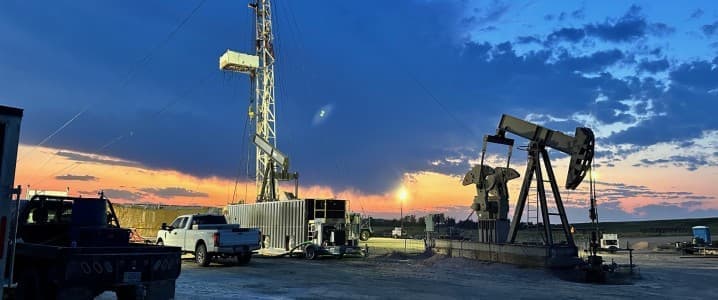Business
U.S. Shale Faces Challenges as OPEC+ Increases Oil Production

The U.S. shale industry is grappling with significant challenges as OPEC+ resumes previously curtailed oil production. Industry executives have described the situation as a “price war,” with implications that could stifle growth in U.S. shale output. According to the International Energy Agency (IEA), the impending surplus in oil supply exacerbates the issue, leading to concerns about the future of shale production in the United States.
Kirk Edwards, chief executive of Latigo Petroleum, emphasized the industry’s cautious approach, stating, “We are not going to be putting any more rigs out until prices get back and stabilize in the $75 range ahead.” He predicts that U.S. oil production will begin to decline by the fall of 2025 and continue into 2026. This sentiment starkly contrasts with the outlook from major players like Exxon and Chevron, both of which have plans for growth in the U.S. shale sector. Additionally, Diamondback Energy’s new chief executive recently highlighted that the shale industry is “pushing the limits of efficiency,” a notable shift from previous warnings that growth had peaked.
Despite some optimistic outlooks, experts suggest that the immediate future does not promise substantial output increases for the shale industry. The primary factor influencing this is OPEC+, which has a history of manipulating oil prices to maintain its market share. Scott Sheffield, former chief executive of Pioneer Natural Resources, noted that “the best way [for OPEC] to gain market share is to keep oil prices in the $60s range for several years.” This strategy aims to suppress investment in U.S. shale and other oil-producing regions worldwide.
A recent report from the Financial Times indicated that Saudi Arabia is already feeling the impact of low oil prices. The kingdom is reportedly curbing spending on its diversification plans due to financial pressures stemming from reduced oil revenues. The chief economist of the Abu Dhabi Commercial Bank warned that a prolonged decline in oil prices would necessitate a deeper government spending retrenchment to address the fiscal shortfall.
The IEA’s projections for global oil demand growth further complicate matters. The agency recently revised its expectations, forecasting a growth rate of only 680,000 barrels per day (bpd) this year, slightly increasing to 700,000 bpd in 2026. These figures highlight a potential glut in global inventories, surpassing levels seen during the pandemic-related lockdowns in 2020.
While the IEA acknowledges that its forecasts are not always accurate, the current dynamics suggest a challenging environment for both OPEC+ and U.S. shale producers. The IEA’s latest Short-Term Energy Outlook indicates that low oil prices in early 2026 will likely prompt reductions in supply from both OPEC+ and some non-OPEC producers, which could help stabilize inventory increases later that year.
Interestingly, the IEA’s recent reports have often cited the growth of electric vehicle (EV) sales as a factor contributing to declining oil demand. However, this month, the agency attributed lower demand growth in key markets, including India, Brazil, and China, to a sluggish global economy. This economic slowdown could be linked to tariffs imposed during the Trump administration, which may be affecting trade dynamics in those vital markets.
As the U.S. shale industry faces these multifaceted challenges, the interplay between OPEC+ strategies and global economic conditions will be crucial in shaping its future trajectory. The need for a balanced approach to supply and demand remains imperative for the sustainability of both U.S. shale production and global oil markets.
-

 Politics4 weeks ago
Politics4 weeks agoSecwepemc First Nation Seeks Aboriginal Title Over Kamloops Area
-

 World5 months ago
World5 months agoScientists Unearth Ancient Antarctic Ice to Unlock Climate Secrets
-

 Entertainment5 months ago
Entertainment5 months agoTrump and McCormick to Announce $70 Billion Energy Investments
-

 Science5 months ago
Science5 months agoFour Astronauts Return to Earth After International Space Station Mission
-

 Lifestyle5 months ago
Lifestyle5 months agoTransLink Launches Food Truck Program to Boost Revenue in Vancouver
-

 Technology3 months ago
Technology3 months agoApple Notes Enhances Functionality with Markdown Support in macOS 26
-

 Lifestyle3 months ago
Lifestyle3 months agoManitoba’s Burger Champion Shines Again Amid Dining Innovations
-

 Top Stories2 months ago
Top Stories2 months agoUrgent Update: Fatal Crash on Highway 99 Claims Life of Pitt Meadows Man
-

 Politics4 months ago
Politics4 months agoUkrainian Tennis Star Elina Svitolina Faces Death Threats Online
-

 Sports5 months ago
Sports5 months agoSearch Underway for Missing Hunter Amid Hokkaido Bear Emergency
-

 Politics5 months ago
Politics5 months agoCarney Engages First Nations Leaders at Development Law Summit
-

 Technology5 months ago
Technology5 months agoFrosthaven Launches Early Access on July 31, 2025





















